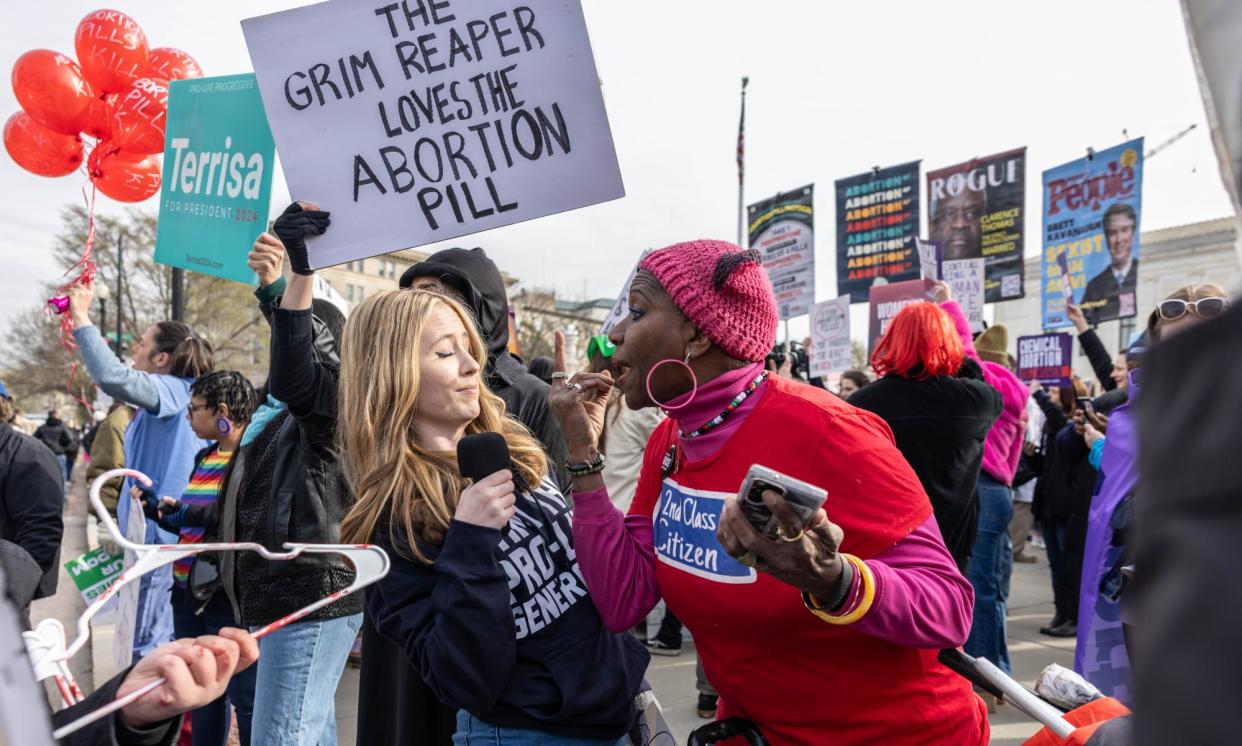Clashing convictions mark protests as US supreme court weighs abortion pill

Supporters and opponents of abortion rights gathered on the steps of the supreme court on Tuesday, where, just beyond the marbled columns, the justices were hearing oral arguments in the most consequential abortion-related case since it overturned Roe v Wade nearly two years ago.
At stake is the accessibility of mifepristone, the first pill in a two-drug regimen used in nearly two-thirds of all abortions in the country.
Related: US supreme court abortion pill hearing: key takeaways
In clashing speeches, advocates shared their abortion stories, with one speaker describing how the experience drove her to shun the procedure and another sharing how the decision to terminate her pregnancy allowed her to leave an abusive relationship and pursue a career in medicine.
“This is something I shouldn’t have to reveal to strangers or to politicians for my choice to be respected,” Brittany House, a patient advocate with Planned Parenthood, told the hundreds of pro-choice supporters.
“An abortion,” House continued, “is supposed to be between a patient and their provider.”
Yards away, a group of abortion opponents lay on the ground with red balloons that said “abortion kills”. A pregnant woman had scrawled “fully human” on her bare belly.
“We’d like to see the FDA really step up and bring back some of those commonsense protections for women,” said Felipe Avila of the National Association of Pro-Life Nurses, repeating the disputed claim at the heart of the case that the FDA-approved pill is dangerous.
Self-managed abortions have soaredsince the supreme court eliminated federal protection for abortion in June 2022, paving the way for nearly two dozen states to restrict or ban access to the procedure. Decades of research have concluded that a combination of mifepristone and misoprostol is a safe and effective method for terminating a pregnancy in the first trimester.
“It allows them to access medication abortion in the comfort and privacy of their own home,” said Divya Shenoy, a family medicine physician and the director of primary care at the Planned Parenthood of Metropolitan Washington. “Not being able to have this option would be really, really challenging for a lot of patients who are trying to seek abortion care.”
Inside the courtroom, a majority of the justices appeared skeptical of the arguments in favor of restricting access to mifepristone put forth by a group of anti-abortion doctors.
Outside, pop music blared as activists squared off in testy exchanges that did little to win converts on one of the most deeply held convictions in American life.
One young anti-abortion activist carried a bound version of the Heritage Foundation’s Project 2025, an 887-page conservative-policy blueprint for a Trump second term that instructs the next president to work with Congress “to enact the most robust protections for the unborn that Congress will support”.
A pro-choice activist came dressed as Anthony Comstock, the 19th-century anti-vice crusader behind the eponymous Comstock Act. Some conservatives and Trump allies see enforcement of the 1873 law, which barred the mailing of “lewd” materials including drugs that could be used to terminate a pregnancy, as a possible path to banning abortion nationwide without Congress.
The activist, wearing mutton chops and a top hat and speaking as Comstock, said: “I am back as a representative of the century they want to bring us back to.”
Mr. Comstock of the eponymous Comstock Act came back to “support my fellow brethren.” pic.twitter.com/lY2CwwLjKa
— Lauren Gambino (@laurenegambino) March 26, 2024
A group of abortion-rights protesters was part of a planned act of civil disobedience intended to highlight the gravity of the case that could once again dramatically reshape the legal landscape, including in states that protect abortion. About 14 people were arrested, according to the groups involved.
The case, which could be decided in June, may also have profound implications in the race for the White House. Even as conservative lawmakers roll back abortion access, voters have repeatedly chosen to protect it at the ballot box, even in deep red states.
Julie von Haefen, a Democratic state lawmaker from battleground North Carolina who attended the rally at the supreme court, said abortion would be a defining issue of the 2024 election, especially in suburban areas like the one she represents.
“After Trump, suburban women rose up and said: ‘We don’t want this, we don’t want any more bans, we want to be able to control her healthcare decisions,’” Von Haefen said in an interview. “It’s definitely something that people talk a lot about in areas like mine.”
In a nod to how important advocates believe the issue will be this election, activists carried mock-campaign signs that said “Mife & Miso 2024”.
Moments before oral arguments began, Mira Michels of Aid Access, an organization that mails abortion pills to people across the US, swallowed a mifepristone pill dispensed to her by a roving “Roe-bot”. After a swig of water, she declared: “Tastes like freedom.”
The robots are operated remotely from states with so-called shield laws, which protect clinicians who serve patients in states where providing abortion is illegal. In practice, a patient would have a telehealth appointment with a provider, and the machine would then dispense the pill.
Mifepristone dispensing robots pic.twitter.com/FfMXj2d5Xe
— Lauren Gambino (@laurenegambino) March 26, 2024
Rebecca Gomperts, the Dutch physician who founded Aid Access, said the machines were intended “to show that we’re not living in the Middle Ages. We live in the 21st century and we’re not going back.”
No matter how the justices rules, Gomperts said her group would continue to find ways to help American women access medication abortion.
“This case is not about taking this off the market yet,” she said. “So it will continue to be available and our providers are going to continue to ship it to women in all 50 states.”


